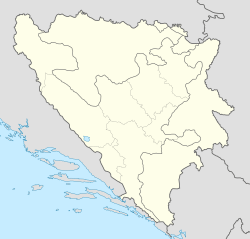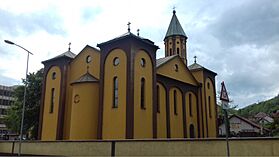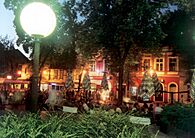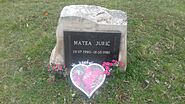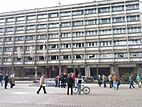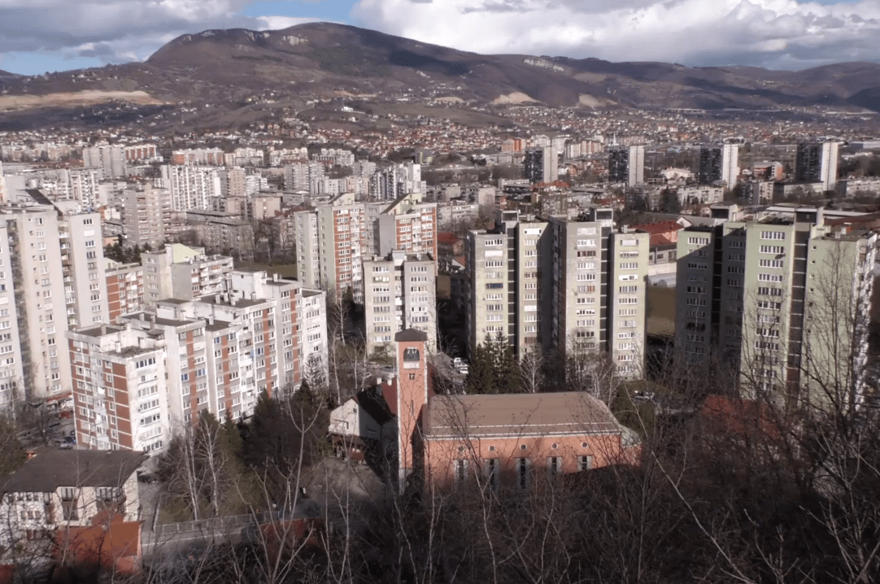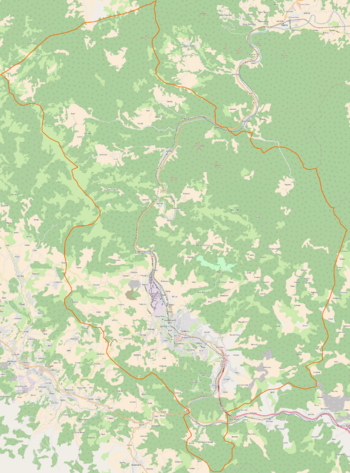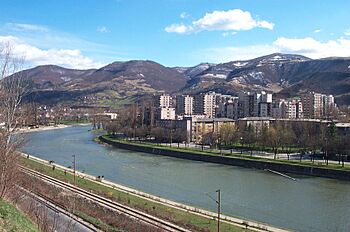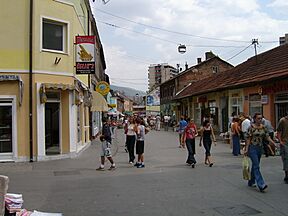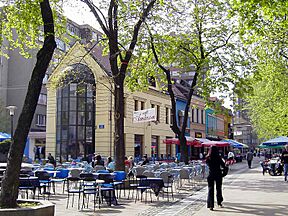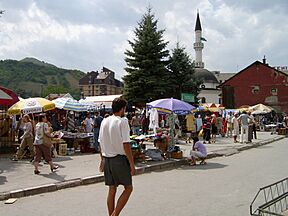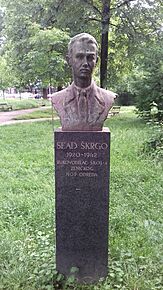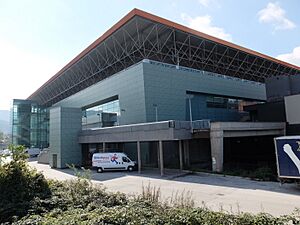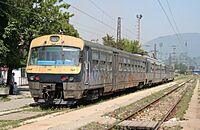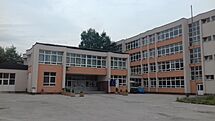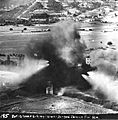Zenica facts for kids
Quick facts for kids
Zenica
Зеница
|
|||
|---|---|---|---|
| Grad Zenica Град Зеница City of Zenica |
|||
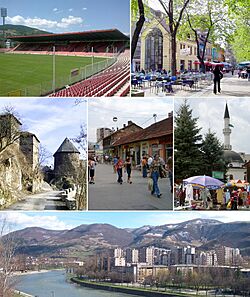
From top, left to right: Bilino Polje Stadium; Old Čaršija; Vranduk fortress; čaršija (by the bazaar); old bazaar and Kočeva mosque; panorama with a view of river Bosna, settlements and hills
|
|||
|
|||
| Etymology: from Proto-Slavic zěnica ("pupil") | |||
| Nickname(s):
Steel/Iron city, Nicaze
|
|||

Location within Bosnia and Herzegovina
|
|||
| Country | |||
| Entity | Federation of Bosnia and Herzegovina | ||
| Canton | |||
| Earliest findings | 3,000–2,000 BC (Drivuša, Gradišće) |
||
| First name | 2nd–4th century (Bistua Nuova) |
||
| Current name | 1415 or March 1436 (Zenica) |
||
| 1st Mayor | before 1908 (Ahmetaga Mutapčić) |
||
| Municipality became City | 20 November 2014 (Zenica City) |
||
| Government | |||
| • Body | Council | ||
| Area | |||
| • City | 558.5 km2 (215.6 sq mi) | ||
| • Urban | 43.01 km2 (16.61 sq mi) | ||
| Elevation | 310–350 m (1,017–1,148 ft) | ||
| Population
(2013)
|
|||
| • City | 110,663 | ||
| • Density | 198.143/km2 (513.19/sq mi) | ||
| • Urban | |||
| Demonym(s) | Zenican (Bosnian: Zeničanin / Зеничанин) | ||
| Time zone | UTC+1 (CET) | ||
| • Summer (DST) | UTC+2 (CEST) | ||
| Postal code |
BA-72000
(for whole Zenica City, including Zenica city) BA-72100 (for Zenica city only as settled place) |
||
| Area code(s) | +387 32 | ||
Zenica is a city in Bosnia and Herzegovina. It is an important center for the Federation of Bosnia and Herzegovina's Zenica-Doboj Canton. The city is located in the Bosna river valley, about 70 kilometers (43 miles) north of Sarajevo.
Zenica is famous for its Ironworks Zenica factory. It is also a big university city. In 2013, the city of Zenica had 70,553 people. The wider area had 110,663 people. This makes it the fourth-largest city in the country.
The city has grown in different stages over time. This includes periods from the Stone Age, the Illyrian time, and the Roman Empire. The Romans called it Bistua Nuova. Early Christian churches were also found here. The oldest things found in Zenica are from 3000–2000 BC. They were found in places like Drivuša and Gradišće.
The name Zenica was first used in 1415. A medieval church and a monastery have been found in Zenica. The history of Medieval Bosnia is linked to Zenica. During the time of the Ottoman Empire (1463–1878), Zenica became a Muslim town. Most people were Muslims by the late 1600s. Orthodox and Catholic Christians, and Jews, came later. Modern Zenica was built mostly during the Austro-Hungarian and Yugoslavian times. The number of people grew fast in the 1900s. But from the Bosnian War until 2013, the city lost many people. Zenica officially became a city in 2014.
Zenica is in the middle of Bosnia. The city area is 43.01 square kilometers (16.61 sq mi). The wider city area is 558.5 square kilometers (215.6 sq mi). It is about 310–350 meters (1,017–1,148 feet) above sea level. The rivers Bosna, Lašva, Babina, and Kočeva flow through the city. The climate is moderate continental.
Zenica has nine national monuments. The football club Čelik is very well known. The city also has one of the tallest buildings in Bosnia and Herzegovina, called Lamela. Many famous people are from Zenica. These include Semir Osmanagić, Danis Tanović, and Amel Tuka.
Contents
- What Does the Name Zenica Mean?
- A Look at Zenica's Past
- Zenica's Location and Natural Features
- How Many People Live in Zenica?
- Zenica's Economy
- Culture and Arts in Zenica
- Places to Visit in Zenica
- Sports in Zenica
- Getting Around Zenica
- Learning and Education
- Media in Zenica
- Famous People from Zenica
- Zenica's Partner Cities
- Images for kids
- See also
What Does the Name Zenica Mean?

There are a few ideas about where the name Zenica comes from.
One story says the city was named after the pupil of the eye. In some local languages, "zenica" means pupil. There is also a legend about Queen Katarina Kosača Kotromanić. When she left Bosnia in 1463, she supposedly said, "My pupil is left behind!" This was because of the city's central location.
Another idea is that the name comes from the word zenit, which means zenith. This also points to Zenica being in the center of Bosnia and Herzegovina.
A Look at Zenica's Past
 Kingdom of Bosnia 1436–1461
Kingdom of Bosnia 1436–1461 Ottoman Empire 1461–1878
Ottoman Empire 1461–1878 Austro-Hungarian Empire 1878–1918
Austro-Hungarian Empire 1878–1918 State of Slovenes, Croats and Serbs 1918
State of Slovenes, Croats and Serbs 1918 Kingdom of Serbs, Croats and Slovenes 1918–29
Kingdom of Serbs, Croats and Slovenes 1918–29 Kingdom of Yugoslavia 1929–41
Kingdom of Yugoslavia 1929–41 Independent State of Croatia 1941–45
Independent State of Croatia 1941–45 DF Yugoslavia 1945–46;
DF Yugoslavia 1945–46;
 FPR/SFR Yugoslavia 1946/1963–92
FPR/SFR Yugoslavia 1946/1963–92 Republic of Bosnia and Herzegovina 1992–95
Republic of Bosnia and Herzegovina 1992–95 Bosnia and Herzegovina 1995–present
Bosnia and Herzegovina 1995–present
The city of Zenica grew over many years. It started with people living here in the Stone Age. Then came the Illyrians and the Romans. The Romans built a town called Bistua Nuova. Early Christians also lived here.
Old settlements have been found in the Bilimišće area. In nearby villages, archaeologists found remains of Roman country houses, baths, and temples.
Zenica in Ancient Times
The oldest things found in Zenica are from 3000 to 2000 BC. These were found in Drivuša and Gradišće. Metal axes, arrows, and pottery were found near Nemila and other places.
The Illyrians arrived in this area around 6th to 5th centuries BC. They built strong defensive structures called "gradinas." The word "gradina" comes from a word meaning "to build." Zenica was already a settled place in the Stone Age and during the Illyrian period. Names like Gradišće and Gradac show this. A place called Gradina in Kopilo village suggests people lived here around 2000 BC.
Recent studies show that people and animals lived near Zenica over 3,100 years ago. Skeletons of pigs, cattle, and goats were found in Kopilo. This means people were farming there. Two tombs and a new ancient settlement were also found.
The Roman Era
The Romans tried to take control of this region around 3rd century BC. They ruled here from the 6th to the 9th centuries AD. Zenica was very important during the first six centuries AD. It was home to a major Roman town and a Christian center called Bistua Nuova. This was the main place for Roman Christianity in Bosnia before the Slavs arrived.
An important road passed through Bistua Nuova. It connected to other major cities like Salona and Srebrenica.
Around the 7th century, invaders from the north destroyed Bistua Nuova. These invaders included the Goths, Avars, and Slavs. The Slavs settled in the middle part of the Bosna river valley, where Zenica is. They formed small communities. It took almost a century for the first Slavic countries to form after these invasions.
Zenica in the Middle Ages
Not much is known about Zenica in the Middle Ages. The city's current name was first written down on March 16, 1436. It was mentioned in documents about the Republic of Ragusa. A place called "Bilina poila" is mentioned in a document from 1203. This is part of Zenica today. This document talks about a group of Bogomils who gave up their beliefs. The presence of Bogomils in Zenica is shown by old documents and tombstones.
In the Middle Ages, the settlement of Klopče was mentioned in 1370. A medieval church and a Franciscan monastery were found in the Zenica area of Varošište.
Zenica Under Ottoman Rule
The Ottomans first came to Zenica in 1415. This was after their victory over Hungarian soldiers. Zenica has been known by its current name since then. The first official record of the city's name is from March 16, 1436. This document talks about an Ottoman leader who retreated towards Zenica.
During Ottoman rule (1463–1878), Zenica changed. It became a town with mosques, schools, and other Islamic buildings. In 1697, Zenica had 2,000 people, mostly Muslims. Orthodox and Catholic Christians, and Jews, were mentioned later in the 18th and 19th centuries.
The Austro-Hungarian Period
After 1878, the Austro-Hungarian monarchy took control of Bosnia and Herzegovina. Zenica was a place where talks happened between Ottoman and Austro-Hungarian leaders to end fighting.
During this time, Zenica grew a lot. A railway was built in 1879. A coal mine opened in 1880, a paper factory in 1885, and ironworks in 1892. A prison was built in 1886. In 1908, a power station brought electric streetlights to the city. Schools were also opened. Cultural groups and clubs were formed. The first cinema in Zenica opened in 1910.
Zenica in the 20th Century
By the early 1900s, Zenica was growing fast. The number of people increased a lot. In 1910, the town had 7,215 people. Many new buildings were constructed. These included the Orthodox Church of the Nativity of Our Lady in 1885, two Catholic churches in 1910, and a synagogue in 1903. Hotels, schools, and modern roads were also built.
After World War I, Zenica became part of the Kingdom of Yugoslavia. The city's growth slowed down until just before World War II. Then, money was invested in the city's ironworks.
Zenica in Yugoslavia
Zenica was freed by partisans on April 12, 1945. This day is now celebrated as Zenica Liberation Day. After the war, Zenica became a big industrial city. It grew to include nearby villages. New apartment buildings were built for the many coal miners and steelworkers. The city's population grew from about 15,000 in 1948 to over 96,000 by 1991.
The Bosnian War
In 1991, before the Bosnian War, Zenica had one of the first private radio stations in Eastern Europe.
During the war, on April 19, 1993, sixteen people died and fifty were hurt in the city's central market. This happened when a grenade hit the area. Zenica was cut off from the rest of the world for a year and a half. The city faced many problems like lack of electricity. Many people moved during the war. Muslims (now called Bosniaks) came to Zenica, and Serbs moved to other areas.
Zenica in the 21st Century
Zenica has slowly recovered from the war. For twenty years, the city was led by the Party of Democratic Action (SDA). This group faced issues with public services. Some parts of the city did not have good lighting, water, or paved roads.
Between 1991 and 2013, Zenica lost about a quarter of its people. This was due to the war and also because young and middle-aged people moved away. They went to other parts of Europe and the United States for better opportunities.
In 2014, Zenica had citizen protests, like other cities in Bosnia and Herzegovina. Some buildings were damaged. Several officials left their jobs. In the same year, Zenica changed from being a municipality to a city.
In 2016, Fuad Kasumović became the mayor. He focused on improving the city. City lighting was added, and water and sewer systems were updated. Roads were paved, and many bicycle lanes were built. In 2019, a bike-sharing system was started. Plans were made for a new heating system. New Year's concerts began on the main square. Many other events have been organized, like the Zenica summer fest and music festivals. These events have helped the city's economy. The city has also worked on reducing pollution and improving public transport. It plans to solve unemployment and update education.
Zenica's Location and Natural Features
Zenica is in the middle of Bosnia. It is in the central part of the Bosna river valley. The city is about 310–350 meters (1,017–1,148 feet) above sea level.
Mountains and Hills
Zenica is in a valley surrounded by hills. The average height of the city is 310–350 meters (1,017–1,148 feet). But there are many higher places. For example, Tvrtkovac, a hiking spot, is 1,304 meters (4,278 feet) high. The Zenica valley is about 35 kilometers (22 miles) long. Its average height is 700 meters (2,300 feet).
Here are some of the highest mountains and hills around Zenica:
| Mountains and hills | Elev. [m (ft)] |
|---|---|
| Tvrtkovac | 1,304 (4,278) |
| Hum | 1,280 (4,200) |
| Vepar | 1,083 (3,553) |
| Lisac | 1,080 (3,540) |
| Smetovi | 940 (3,080) |
| Klopačke stijene | 918 (3,012) |
| Golubak | 700 (2,300) |
| Vučijak | 639 (2,096) |
| Zmajevac | 638 (2,093) |
| Volovska glava | 585 (1,919) |
| Janjićki vrh | 561 (1,841) |
The lowest parts of Zenica are along the Bosna river. The areas to the northwest and northeast are the highest.
Rivers and Waterways
Zenica has many small rivers and streams. All of them flow into the Bosna river.
The Bosna is the most important river in Zenica. It starts near Sarajevo and flows into the river Sava. The river flows from south to north. About 47.95 kilometers (29.80 miles) of the river are in the city. Many homes, roads, and railways are built along it.
Besides the Bosna, the rivers Lašva, Babina, and Kočeva also flow through Zenica.
Zenica's Climate
Zenica has a moderate continental climate. Summers are hot, and winters are moderately cold. The average yearly temperature is 10.4°C (50.7°F). The average yearly rainfall is 804 millimeters (31.7 inches). March usually has the least rain, and November has the most.
January is the coldest month, with an average low of -1°C (30°F). July is the hottest, with an average high of 20.2°C (68.4°F). The lowest average monthly temperature was -6.4°C (20.5°F) in January 1964. The lowest daily temperature ever was -23.9°C (-11.0°F) in January 1963. The highest average monthly temperature was 23.8°C (74.8°F) in August 2003. The highest daily temperature was 42.6°C (108.7°F) in August 2024.
| Climate data for Zenica, 1991–2020 | |||||||||||||
|---|---|---|---|---|---|---|---|---|---|---|---|---|---|
| Month | Jan | Feb | Mar | Apr | May | Jun | Jul | Aug | Sep | Oct | Nov | Dec | Year |
| Mean daily maximum °C (°F) | 4.9 (40.8) |
8.6 (47.5) |
13.9 (57.0) |
19.1 (66.4) |
23.7 (74.7) |
27.6 (81.7) |
29.7 (85.5) |
30.1 (86.2) |
24.5 (76.1) |
19.0 (66.2) |
11.7 (53.1) |
5.3 (41.5) |
18.2 (64.7) |
| Mean daily minimum °C (°F) | −2.8 (27.0) |
−1.8 (28.8) |
1.5 (34.7) |
5.2 (41.4) |
9.4 (48.9) |
13.2 (55.8) |
14.7 (58.5) |
14.6 (58.3) |
10.9 (51.6) |
6.9 (44.4) |
2.9 (37.2) |
−1.5 (29.3) |
6.1 (43.0) |
| Average precipitation mm (inches) | 54.7 (2.15) |
54.1 (2.13) |
54.6 (2.15) |
69.4 (2.73) |
80.5 (3.17) |
86.9 (3.42) |
83.9 (3.30) |
60.3 (2.37) |
80.3 (3.16) |
70.8 (2.79) |
77.3 (3.04) |
69.4 (2.73) |
842.2 (33.14) |
| Average precipitation days (≥ 1 mm) | 9.2 | 8.5 | 8.6 | 10.0 | 10.1 | 10.1 | 8.7 | 6.3 | 8.4 | 7.7 | 8.3 | 9.0 | 104.9 |
| Source: World Meteorological Organization | |||||||||||||
Zenica's Environment
Zenica's factories have caused some pollution. After the Bosnian War, the main factory, the ironworks, stopped working for a while. But when it started again, a group of citizens called Eko pokret Zenica began to protest. They worked with the local Greens of Bosnia and Herzegovina party.
The Babina river basin was made a nature park because of their efforts. The city also thought about building a dam on the Vranduk river. But the Greens of Bosnia and Herzegovina and Eko pokret were against it. They want Vranduk to be a national park.
City Neighborhoods
The main parts of Zenica include these neighborhoods:
- Jalija
- Odmut
- Mokušnice
- Londža
- Pišće
- Blatuša
- Crkvice
- Babina River (Old Radakovo)
- New Radakovo (Novo Radakovo)
- Sejmen
- Old Čaršija (toward Čaršijska mosque)
- New Zenica (Nova Zenica)
- Lukovo Field (Lukovo Polje)
How Many People Live in Zenica?
Zenica's population grew from 7,215 in 1910 to 96,027 in 1991.
According to the 2013 census, Zenica city had 70,553 people. The wider Zenica area had 110,663 people.
Zenica City Population Changes
| Ethnic composition | |||||||||||||
| Year | Serbs | % | Bosniaks | % | Croats | % | Yugoslavs | % | Others | % | Total | ||
|---|---|---|---|---|---|---|---|---|---|---|---|---|---|
| 1961 | 10,525 | 32.41% | 5,908 | 18.19% | 9,393 | 28.92% | 5,517 | 15.31% | - | -% | 32,476 | ||
| 1971 | 12,779 | 24.93% | 21,365 | 41.68% | 13,250 | 25.85% | 1,945 | 3.79% | - | -% | 51,263 | ||
| 1981 | 12,728 | 20.02% | 22,146 | 34.84% | 11,716 | 18.43% | 14,437 | 22.71% | - | -% | 63,569 | ||
| 1991 | 18,312 | 19.07% | 43,154 | 44.94% | 15,809 | 16.46% | 14,703 | 15.31% | 4,049 | 4.22% | 96,027 | ||
| 2013 | 2,296 | 3.25% | 55,239 | 78.29% | 6,746 | 9.56% | - | -% | 6,272 | 8.89% | 70,553 | ||
| Population of Zenica city | ||
|---|---|---|
| Year | Pop. | ±% p.a. |
| 1879 | 2,101 | — |
| 1885 | 3,073 | +6.54% |
| 1910 | 7,215 | +3.47% |
| 1921 | 7,632 | +0.51% |
| 1948 | 15,550 | +2.67% |
| 1953 | 28,961 | +13.24% |
| 1961 | 32,476 | +1.44% |
| 1971 | 51,263 | +4.67% |
| 1981 | 63,569 | +2.17% |
| 1991 | 96,027 | +4.21% |
| 2013 | 70,553 | −1.39% |
Zenica Municipality Population Changes
| Ethnic composition | |||||||||||||
| Year | Serbs | % | Bosniaks | % | Croats | % | Yugoslavs | % | Others | % | Total | ||
|---|---|---|---|---|---|---|---|---|---|---|---|---|---|
| 1961 | 20,369 | 24.15% | 31,177 | 36.97% | 20,509 | 24.32% | 10,755 | 12.75% | - | -% | 84,341 | ||
| 1971 | 21,875 | 19.45% | 61,204 | 54.43% | 24,658 | 21.93% | 2,133 | 1.90% | 2,577 | 2.29% | 112,447 | ||
| 1981 | 21,204 | 15.97% | 66,930 | 50.42% | 23,595 | 17.78% | 17,536 | 13.21% | - | -% | 132,733 | ||
| 1991 | 22,592 | 15.52% | 80,377 | 55.21% | 22,651 | 15.56% | 15,651 | 10.75% | 4,306 | 2.96% | 145,577 | ||
| 2013 | 2,409 | 2.17% | 92,988 | 84.02% | 8,279 | 7.48% | - | -% | 6,987 | 6.31% | 110,663 | ||
| Population of Zenica City (Municipality till 2014) | ||
|---|---|---|
| Year | Pop. | ±% p.a. |
| 1879 | 4,174 | — |
| 1885 | 6,261 | +6.99% |
| 1910 | 10,637 | +2.14% |
| 1921 | 11,211 | +0.48% |
| 1948 | 35,399 | +4.35% |
| 1953 | 38,152 | +1.51% |
| 1961 | 84,341 | +10.42% |
| 1981 | 132,733 | +2.29% |
| 1991 | 145,577 | +0.93% |
| 2013 | 110,663 | −1.24% |
Common Family Names
In Zenica-Doboj Canton, some of the most common family names are:
- Hodžić
- Halilović
- Delić
- Spahić
- Bašić
- Imamović
- Kovačević
- Kadrić
- Tadić
- Marković
- Babić
- Begić
- Alić
- Šehić
- Selimović
- Beganović
- Hadžić
- Muratović
- Tomić
- Šišić
- Dedić
- Karić
- Smajić
- Sinanović
- Jukić
- Vidović
- Ramić
- Dizdarević
- Brkić
- Softić
- Avdić
- Pavlović
- Matijević
- Bošnjak
- Pašalić
- Šabanović
- Fejzić
- Radić
- Kovač
- Lukić
- Petrović
- Hasić
Zenica's Economy
Zenica is an industrial city. Its main industries are making iron and steel, and mining coal. Coal mining started in Zenica in 1880. Steel production began in 1892.
In 1990, the city produced 1.4 million tons of steel and 924,000 tons of coal. It also made cloth and milk. Many people worked in factories and other businesses.
The Bosnian War (1992–1995) hurt Zenica's economy. Steel production decreased.
Farming and raising animals are also important for Zenica's economy. Common crops include potatoes, carrots, onions, corn, and wheat.
Culture and Arts in Zenica
Zenica has many cultural places. These include the Camera Symphony Orchestra, Bosnian People's Theater, Youth chorus, Art gallery, and Museum of the City of Zenica.
The Croat culture society Napredak organizes yearly Easter events. Another event is the "Festival of rakijas and liqueurs."
Several music groups are from Zenica. These include the medieval music group Ensemble Fugato, the reggae/dub/rock band Dubioza kolektiv, and the pop-rock band Nemoguće Vruće.
Important National Monuments
Zenica has several national monuments:
- Church of the Nativity of Our Lady
- St. Elijah Church
- Former Zenica paper factory
- Plate of the great judge Gradeša
- Sejmenska mosque
- Old mosque
- Vranduk fortress
- Sultan Ahmedova mosque
Places to Visit in Zenica
- Zenica Synagogue
- Zenica prison
- Arena Zenica
- NK Čelik Zenica football club
- Bilino Polje Stadium football stadium
Sports in Zenica
Zenica has many sports facilities and clubs. Its teams have won many awards.
The NK Čelik Zenica football club has won the former Central European Cup twice. They have also been national champions three times. The city's rugby team has won several national championships. Famous athletes from Zenica include tennis player Mervana Jugić, high jumper Elvir Krehmić, and karateka Arnel Kalušić.
Scouting in Zenica
Scouts are a group for children and young people. They learn to work together and gain useful skills. These skills help them in nature and in the city. In 2017, the Zenica scouting group celebrated its 65th anniversary. About 100,000 young people have been part of the scouts since it started.
Sports Clubs List
- Atletski klub "Zenica" (athletics)
- Biciklistički klub "Zenica – Metalno" (cycling)
- Bokserski klub "Čelik" (boxing)
- Invalidski odbojkaški klub "Bosna" (disabled volleyball)
- Džudo klub "Policajac" (Judo)
- Karate klub "Hasen-do"
- Karate klub "Zenica – Mladost"
- Karate klub "Nico"
- Košarkaški invalidski klub "Bosna" (disabled basketball)
- Klub borilačkih vještina "Isak" (martial arts)
- Klub ekstremnih sportova "Scorpio" (extreme sports)
- Košarkaški klub "Čelik" (women's basketball)
- Košarkaški klub "Čelik" (basketball)
- Košarkaški klub "Željezara – Zenica" (women's basketball)
- Klub sjedeće odbojke "Zenica 92" (sitting volleyball)
- Malonogomentni klub "Drugari" (futsal)
- Fudbalski klub "Borac" (Tetovo) (football)
- Fudbalski klub "Iris" (women's football)
- Fudbalski klub "Čelik" (football)
- Fudbalski klub "Nemila" (football)
- Fudbalski klub "Zenica 97" (football)
- Fudbalski klub "Zlatni ljiljan" (football)
- Fudbalski klub "Željezničar" (football)
- Odbojkaški klub "Zenica" (volleyball)
- Odbojkaški klub "Ruki" (volleyball)
- Plivački klub "Željezara" (swimming)
- Rafting klub "Žara" (rafting)
- Rafting klub "Bosna" (rafting)
- Ragbi klub "Čelik" (rugby)
- Ragbi klub "Rudar" (rugby)
- Ragbi klub "Zenica 72" (rugby)
- Rukometni klub "Čelik" (handball)
- Smučarski klub "Zenica" (skiing)
- Stonoteniski klub "Mladost" (table tennis)
- Stonoteniski klub "Željezara" (table tennis)
- Streljački klub "Zenica" (shooting)
- Teniski klub "Čelik" (tennis)
- Tekvondo klub "Zenica" (taekwondo)
- Udruženje građana sportskih ribolovaca RD "Bistro" Zenica (fishing)
Getting Around Zenica
Zenica is connected to Sarajevo (70 kilometers southeast) by train and road. Both follow the Bosna river valley. Highway А1 connects Zenica with Sarajevo and Mostar. The railway goes further south to Ploče in Croatia.
Some important transportation companies in Zenica are Almy Gradnja, ITC, Arcon, Arel, and Almy-transport.
The closest airport is Sarajevo International Airport. In 2019, the city started rebuilding the Vranduk tunnel.
Learning and Education
Zenica has nineteen elementary schools and twelve high schools. The University of Zenica has several different departments, called faculties. These include:
- Mechanical Engineering
- Metallurgy and Materials
- Philosophy
- Law
- Economics
- Medicine
- Islamic Pedagogy
- Polytechnic
Media in Zenica
The city has its own public radio and television station, RTV Zenica. There is also a free local newspaper called Superinfo. The city also publishes an official gazette called Službene novine Grada Zenica. National newspapers like Dnevni avaz and Oslobođenje also have local offices in Zenica.
Famous People from Zenica
- Hasiba Agić, folk singer
- Bruno Akrapović, former football player
- Hamza Alić, shot putter
- Teoman Alibegović, basketball player
- Anabela Basalo, writer
- Sandra Bagarić, soprano and TV presenter
- Kenan Bajramović, basketball player
- Mensur Bajramović, basketball coach
- Elvir Bolić, former football player
- Senad Brkić, football player
- Ante Budimir, football player
- Aljoša Buha, bass player
- Jasmin Burić, football player
- Dragan Čavić, Serb politician
- Jasmin Dizdar, film director
- Tarik Filipović, actor and TV presenter
- Nikolina Grabovac, basketball player
- Ahmet Hadžipašić, former Prime Minister
- Adnan Harmandić, handball player
- Esad Hećimović, investigative journalist
- Arif Heralić, metal worker famous for being on a banknote
- Mirsad Hibić, former football player
- Mirjana Horvat, sport shooter
- Branimir Hrgota, football player
- Amar Gile, pop-folk singer
- Darko Jelčić, drummer
- Mervana Jugić-Salkić, tennis player
- Edin Karamazov, lute player
- Dubioza kolektiv, music band
- Elvir Krehmić, high jumper
- Mladen Krstajić, football player
- Igor Laikert, alpine skier
- Otto Lang, skier and film producer
- Dejan Lovren, football player
- Danijel Ljuboja, theater actor
- Emir Mutapčić, former basketball player and coach
- Ivan Opačak, basketball player
- Semir Osmanagić, archaeologist
- Srećko Pejović, sport shooter
- Mesud Pezer, shot putter
- Vanja Plisnić, basketball player
- Senad Podojak, imam and Quran reciter
- Emir Preldžić, basketball player
- Milorad Ratković, former football player
- Hasan Rizvić, basketball player
- Nermin Šabić, football player
- Zoran Savić, former basketball player
- Vuka Šeherović, folk singer
- Ivan Šunjić, Croatian football player
- Danis Tanović, film director, Oscar winner
- Amel Tuka, middle-distance runner
- Siniša Ubiparipović, former football player
- Nemoguće Vruće, rock band
- Jovan Ćulibrk
Zenica's Partner Cities
Zenica is connected with these international cities as 'Partner Cities':
 Gelsenkirchen, Germany
Gelsenkirchen, Germany Hunedoara, Romania
Hunedoara, Romania Üsküdar, Turkey
Üsküdar, Turkey Karşıyaka, Turkey
Karşıyaka, Turkey Luleå, Sweden
Luleå, Sweden Zalaegerszeg, Hungary
Zalaegerszeg, Hungary Fiorenzuola d'Arda, Italy
Fiorenzuola d'Arda, Italy Veles, North Macedonia
Veles, North Macedonia Jajce, Bosnia and Herzegovina
Jajce, Bosnia and Herzegovina
Images for kids
-
Bosanska vila article (1890) on Fatih Mehmed's conquest of Gradišće and Vranduk in 1463
-
King's birthday, King Peter I street (today's Titova; retouched postcard, 1928)
-
Part of the "Kameni spavač [Stone Sleeper] – Mak Dizdar" monument's vitreous memorial with names of thousands of Zenicans, victims of the Bosnian War (2019)
See also
 In Spanish: Zenica para niños
In Spanish: Zenica para niños




